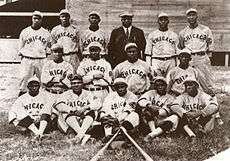Dave Brown (baseball)
| Dave Brown | |||
|---|---|---|---|
 | |||
| Pitcher | |||
|
Born: June 9, 1895 Leon County, Texas | |||
| |||
| debut | |||
| 1917, for the Dallas Black Giants | |||
| Last appearance | |||
| 1926, for the Gilkerson's Union Giants | |||
| Negro league statistics | |||
| Win–loss record | 45–22 | ||
| Earned run average | 3.23 | ||
| Strikeouts | 336 | ||
| Teams | |||
| |||
David Brown (born June 9, 1895)[1] was a left-handed pitcher in Negro league baseball. Considered one of the better pitchers in negro league history, he was also known for serious off-the-field problems. His career came to a premature end when he became a fugitive after allegedly killing a man in 1925.
Early career
Brown was born in Leon County, Texas.[1] He had a good curveball and excellent control. He was also a good fielder and had outstanding speed but was a weak hitter. Brown played with the Dallas Black Giants in 1917 and 1918.[2] He was regarded as a "timid nice guy" who did not cause trouble, but during his time with the Dallas Black Giants he was involved in a highway robbery.[3] Although Brown was reported to have become a fugitive, Rube Foster agreed to pay $20,000 for Brown's parole and he became a member of Foster's Chicago American Giants.[3][4]
Chicago American Giants Seasons

Brown became the ace of the American Giants as they dominated negro league baseball in the early 1920s. From 1920 through 1922, he posted a 29-8 record in league games.[3] His 11-3 record led them to a pennant win in 1921 including three victories in a playoff with the Bacharach Giants.[3][5] His 8-3 record contributed to another pennant in 1922.[6] In the winter following the 1922 season, Brown joined Oscar Charleston for the first season of the Cuban League's Santa Clara Leopardos.[7]
League change and abrupt career end
For the 1923 season, Brown left Rube Foster's American Giants for the brand new Eastern Colored League. Foster voiced his displeasure, pointing out that Brown had been paroled to him and that he had promised Brown's mother to take care of him. He pointed out that the public would vilify him if he revoked.[4] Brown posted a losing record in his first season with the New York Lincoln Giants but he and Charleston returned to Cuba the following winter and helped Santa Clara compile one of the best records in Cuban baseball history.[8][9] His second season with the Lincoln Giants improved on the first and he defeated "Cannonball" Dick Redding and the Brooklyn Royal Giants to win the New York City championship.[3]
Brown's career came to an abrupt end in 1925. He went to a bar one night with Frank Wickware and Oliver Marcelle.[8][10] Marcelle was a third baseman with a reputation for trouble off the field.[10] A fight erupted at the bar, possibly involving cocaine, and Brown killed one of the participants. Wickware and Marcelle were questioned the next day at the ballpark, but Brown had disappeared.[8]
Rumors and legacy
The FBI searched for Brown but he was never officially seen again. Rumors abounded that he continued playing baseball under the alias "Lefty Wilson" with semi-professional teams through the Midwestern United States. Lefty Wilson toured with Gilkerson's Union Giants in 1926,[11] a white team in Bertha, Minnesota in 1927 and 1928, and he was rumored to have played in Sioux City, Iowa in 1929 and Little Falls, Minnesota in 1930. More unsubstantiated rumors claimed that Brown died under mysterious conditions in Denver, Colorado in 1930.[8] However, Lefty Wilson shows up again pitching for the Gilkerson's Union Giants again in 1932.
In 1927, a Pittsburgh Courier column solicited opinions for the best black baseball player of all time. On April 2, John Henry Lloyd announced his list which included Dave Brown.[12] When the Pittsburgh Courier announced a similar list in 1952, they included Brown on their second team.[13]
Notes
- 1 2 "Dave Brown Negro League Statistics & History". baseball-reference.com. Retrieved June 8, 2012.
- ↑ "Plenty of Baseball Provided for Fans of Dallas Today" Dallas Morning News, Dallas, Texas, Sunday, August 11, 1918, Page 8, Column 2
- 1 2 3 4 5 Riley, p. 117.
- 1 2 Cottrell, p. 165.
- ↑ Cottrell, p. 160.
- ↑ Cottrell, p. 163.
- ↑ Heaphy, pp. 173-174.
- 1 2 3 4 Riley, p. 118.
- ↑ Heaphy, p. 174.
- 1 2 James, p. 184.
- ↑ "Gilkerson Union Giants Swamp Knights of Columbus Nine 11 to 4" Davenport Democrat and Leader, Davenport, IA, Monday Evening, June 21, 1926, Page 7, Columns 1 and 2
- ↑ Cottrell, p. 175.
- ↑ Cottrell, p. 182.
References
- Cottrell, Robert Charles (2004). Cottrell The Best Pitcher in Baseball Check
|url=value (help). New York University Press. ISBN 0-8147-1615-6. - Heaphy, Leslie A. (2002). The Negro Leagues, 1869-1960. McFarland & Company. ISBN 0-7864-1380-8.
- James, Bill (2003). The New Bill James Historical Baseball Abstract. Simon & Schuster. ISBN 0-7432-2722-0. (HTML link)
- Riley, James A. (2002). The Biographical Encyclopedia of the Negro Baseball Leagues. foreword by Monte Irvin. Carroll & Graf Publishers. ISBN 0-7867-0959-6.
External links
- Negro league baseball statistics and player information from Seamheads.com, or Baseball-Reference (Negro leagues)
- "Teams list of pitcher John Donaldson"